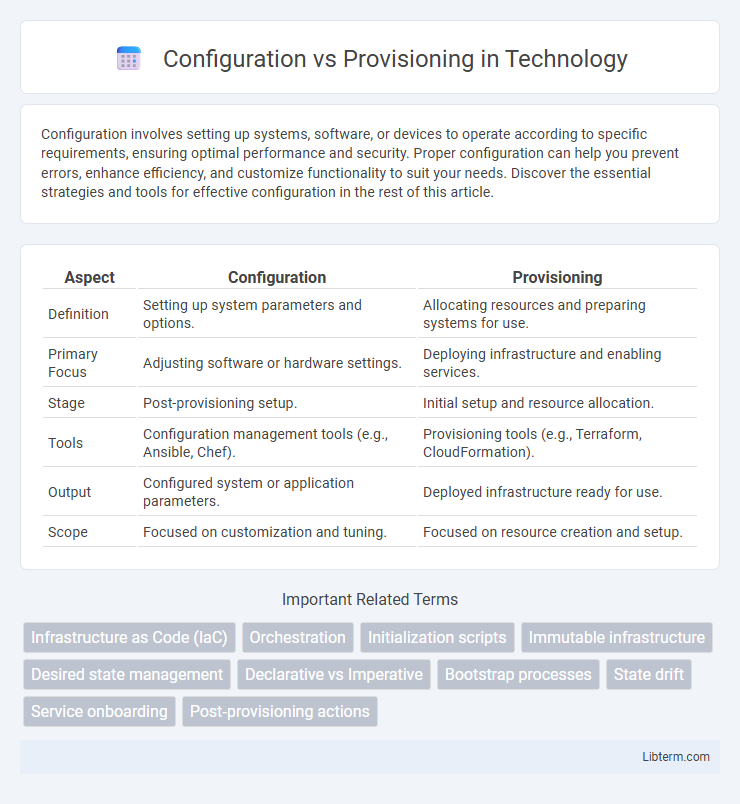Configuration involves setting up systems, software, or devices to operate according to specific requirements, ensuring optimal performance and security. Proper configuration can help you prevent errors, enhance efficiency, and customize functionality to suit your needs. Discover the essential strategies and tools for effective configuration in the rest of this article.
Table of Comparison
| Aspect | Configuration | Provisioning |
|---|---|---|
| Definition | Setting up system parameters and options. | Allocating resources and preparing systems for use. |
| Primary Focus | Adjusting software or hardware settings. | Deploying infrastructure and enabling services. |
| Stage | Post-provisioning setup. | Initial setup and resource allocation. |
| Tools | Configuration management tools (e.g., Ansible, Chef). | Provisioning tools (e.g., Terraform, CloudFormation). |
| Output | Configured system or application parameters. | Deployed infrastructure ready for use. |
| Scope | Focused on customization and tuning. | Focused on resource creation and setup. |
Understanding Configuration and Provisioning
Configuration involves setting up system parameters and options to tailor software or hardware behavior according to specific requirements, optimizing performance and functionality. Provisioning refers to the process of preparing and equipping a network or system with the necessary resources and services to make it operational, including hardware allocation, software installation, and access permissions. Understanding configuration and provisioning is crucial for IT professionals to ensure seamless deployment, customization, and management of technology infrastructures.
Key Differences Between Configuration and Provisioning
Configuration refers to the process of setting up software or devices by adjusting parameters and options to meet specific requirements, while provisioning involves the initial deployment and allocation of resources needed for operation. Key differences include configuration being an ongoing customization activity, whereas provisioning is a one-time setup focused on resource readiness. Configuration typically deals with software settings post-installation, and provisioning encompasses hardware setup, network assignment, and software installation.
The Role of Configuration in IT Infrastructure
Configuration in IT infrastructure involves setting up system parameters, policies, and software settings to ensure that hardware and applications operate according to desired specifications and business requirements. It plays a crucial role in maintaining system stability, security, and performance by enabling standardized environments and reducing errors during deployment. Proper configuration management streamlines updates, enforces compliance, and supports scalability within cloud services, data centers, and network devices.
What is Provisioning?
Provisioning refers to the process of setting up IT resources, such as servers, networks, or software, to ensure they are ready for use. It involves allocating necessary hardware, installing software, and configuring system settings to meet specific operational requirements. Effective provisioning streamlines deployment, reduces manual errors, and supports scalable IT infrastructure management.
Configuration Management Tools and Techniques
Configuration management tools like Ansible, Puppet, and Chef automate the setup and maintenance of software environments, ensuring consistency and compliance across systems. These tools utilize declarative languages and version-controlled configuration files to manage infrastructure as code, enabling repeatable and scalable deployments. Effective configuration management reduces configuration drift, enhances system reliability, and accelerates incident recovery through automated state enforcement.
Provisioning Processes and Best Practices
Provisioning processes involve automating the setup and deployment of resources such as servers, networks, and applications to ensure consistent and efficient infrastructure management. Best practices include using Infrastructure as Code (IaC) tools like Terraform or Ansible for repeatability, integrating continuous integration/continuous deployment (CI/CD) pipelines to streamline updates, and maintaining version control for all configuration scripts to enhance traceability and rollback capabilities. Emphasizing security by implementing role-based access controls (RBAC) and periodic audits during provisioning minimizes risks and ensures compliance with organizational policies.
Use Cases for Configuration vs Provisioning
Configuration involves setting system parameters to tailor software or hardware behavior, ideal for customizing applications to meet user preferences or compliance requirements. Provisioning focuses on allocating and deploying resources such as virtual machines, storage, or network access, essential for onboarding new users or scaling infrastructure quickly. Use cases for configuration include modifying firewall rules or application settings, while provisioning use cases encompass establishing user accounts or deploying cloud environments.
Benefits and Challenges of Configuration
Configuration enhances system customization by allowing precise control over settings, which improves performance and user experience. Challenges include complexity in managing numerous configuration options and the risk of errors leading to system malfunctions. Effective configuration requires thorough documentation and skilled personnel to balance flexibility with stability.
Benefits and Challenges of Provisioning
Provisioning offers rapid deployment and scalability by automatically allocating resources and services, which significantly reduces manual effort and operational errors. However, challenges include ensuring accurate resource allocation to avoid over-provisioning or under-provisioning, managing complex automation workflows, and maintaining security compliance during the provisioning process. Effective provisioning streamlines IT operations but requires robust monitoring and governance to maximize efficiency and cost-effectiveness.
Choosing Between Configuration and Provisioning in Your Workflow
Choosing between configuration and provisioning in your workflow depends on the specific needs of your environment and automation goals. Configuration involves setting up software and system settings to ensure proper operation, while provisioning focuses on preparing and allocating resources such as servers and networks. Effective workflows integrate provisioning to establish infrastructure swiftly and configuration to customize systems, optimizing deployment speed and consistency.
Configuration Infographic

 libterm.com
libterm.com